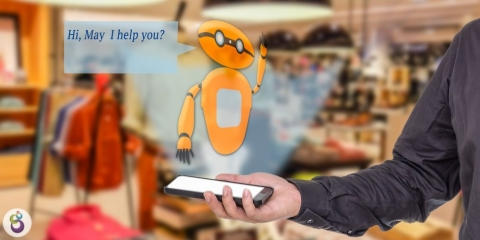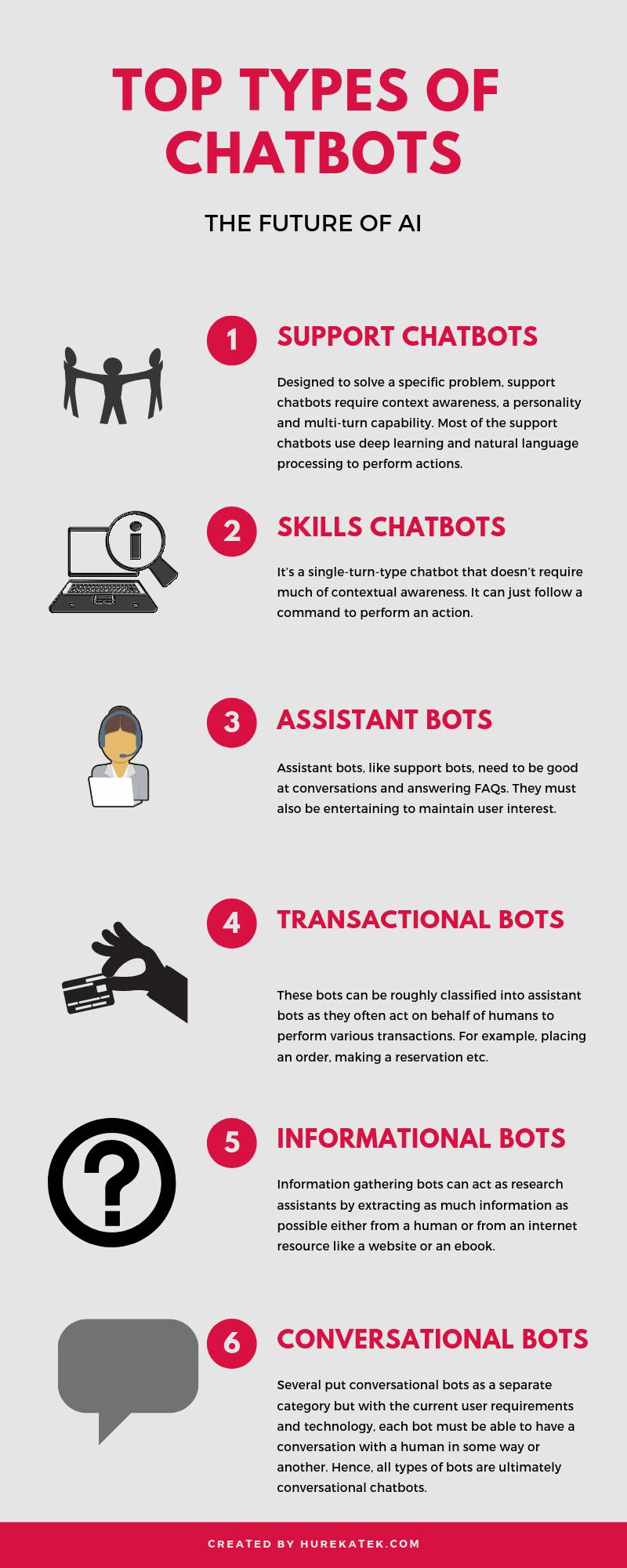How many types of chatbots are there? Some say there are 3 and some have rounded up the number at 7. What’s the correct answer? It depends.
Classification of chatbots depends on two things -
- Problem you’re trying to solve.
- Functionalities you’re trying to incorporate
Depending on that, following are the types of chatbots.
1. Support Chatbots

Designed to solve a specific problem, support chatbots require context awareness, a personality and multi-turn capability. They should be able to walk a user through a business process and answer wide range of FAQs. Most of the support chatbots use deep learning and natural language processing to perform actions. Speech recognition is optional for support chatbots.
Also Read: On Machine Learning Powered Recommendation Engines
A support chatbot finds use in all industries - majorly in retail, human resources, digital marketing and healthcare. Use of chatbots for consumer services in all these industries is becoming a necessity as it saves business resources, and improves customer satisfaction rate.
Use-cases of support chatbots
- Customer service bot
- E-commerce bot with recommendation engine capability
- Food ordering bots
- FAQ bots
2. Skills Chatbots
It’s a single-turn-type chatbot that doesn’t require much of contextual awareness. It can just follow a command to perform an action. For example, a skills chatbot can follow the command ‘switch on the lights’ readily, with its speech recognition functionality. A skills chatbot requires powerful NLP features as well as must be quick to work.
Amazon’s Alexa has great skills chatbots feature, though it’s a bot that can be classified into several types of chatbots.
3. Assistant Bots
Assistant bots, like support bots, need to be good at conversations and answering FAQs. They must also be entertaining to maintain user interest. The most successful example of assistant bots is Siri by Apple, which can not only assist the user with several tasks like fetching the news, making a google search, setting reminders etc but also responds in a funny way if it doesn’t understand the query.
At Hurekatek, we have developed several assistant bots that can integrate with existing platforms like Slack, Facebook and websites to assist with relevant business processes. Our most successful attempt at building an assistant bot are for restaurant and human resources industry where we have built bots that assist with processes like food ordering, making reservations, sharing ingredient information, processing payments, sending notifications and reminders to candidates and taking feedback.
Also Read: 9 Best Uses of Chatbots for Restaurants
4. Transactional Bots
These bots can be roughly classified into assistant bots as they often act on behalf of humans to perform various transactions. For example, placing an order, making a reservation etc. Several custom solutions for transactional bots are possible, helping users increase their productivity as the bot interacts with external systems to perform transactions.
Transactional bots find use in several industries just like support chatbots.
5. Informational & Information Gathering Bots
Both types of bots help either in collecting or in distributing information. For example, a news bot (an informational bot) can send push notifications or offer news recommendations to users with use of AI and text classification technologies.
Information gathering bots can act as research assistants by extracting as much information as possible either from a human or from an internet resource like a website or an ebook.
Information gathering bots are very relevant in the education and corporate training sector as well as in the digital marketing sector for research-based tasks.
These are the top five types of chatbots according to the classification scheme mentioned at the beginning of the post.
About Conversational Chatbots
Several put conversational bots as a separate category but with the current user requirements and technology, each bot must be able to have a conversation with a human in some way or another. Hence, all types of bots are ultimately conversational chatbots.

Conclusion
To sum up, depending on the usability and functionality, chatbots can be of five main types.
Support chatbot with its context awareness, unique personality and conversational nature finds use in several industries and use cases.
Also Read: 5 Reasons Why Using Chatbots in Retail Is A Must
Skills chatbots are able to perform specific tasks for users, acting as great assistants.
Assistant chatbots are basically a combination of support and skills chatbots with capability to both understand humans and follow their instructions.
Transactional chatbots can help reduce the workload in several industries by performing transactions on behalf of humans whereas the informational & information gathering bots can be great for research and distribution of information.
At Hurekatek, we have helped several business owners with chatbots development, developing unique tailored chatbots solutions for businesses. We can help you out too. Get in touch with us for details.





